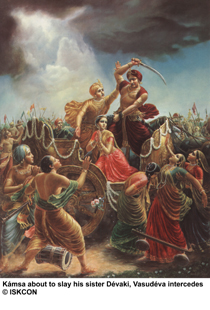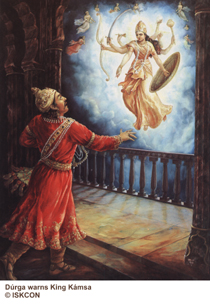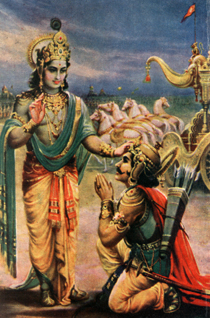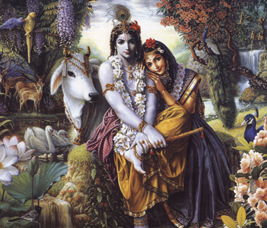Ashutosh Vardhana:
The birth of Lord Kríshna
(Version 2)
Ashutosh Vardhana:
The birth of Lord Kríshna (Version 2) |
Note for Editors:
There are three versions of this article:
- Version 1, length 400 words, which explains the story underlying this festival and its theology (divine incarnations).
- Version 2, length 1330 words, which consists of version 1 plus information of festival customs at home and in temples, the significance of Lord Kríshna for Hindus, and comparisons with Christian beliefs (childhood of Jesus). Additional illustrations can be found in Version 2.
- Version 3, length 890 words, same as version 1, plus information on customs and rituals, but omitting similarities between Kríshna and young Jesus. For greater choice of illustrations see Version 2.
Editorial introduction:
On 31 August this year (2002), Hindus celebrate the festival of Kríshna Janmáshtami, the birth of Lord Kríshna. Ashutosh Vardhana explains the significance of this festival, which has many similarities with Christmas.
Version 2: 1330 words
Ashutosh Vardhana:
The birth of Lord Kríshna
God born as man
![]() Hindus
believe that the one invisible GOD THE ABSOLUTE, manifests in the shape
of many personal gods and appears in material form from time to time to
reduce evil, to support the good and to renew his teaching for mankind.
Hindus
believe that the one invisible GOD THE ABSOLUTE, manifests in the shape
of many personal gods and appears in material form from time to time to
reduce evil, to support the good and to renew his teaching for mankind.
One of the most beloved of the Lord's ten incarnations was when he came in the form of Lord Kríshna, whose birth we celebrate on the day of Kríshna Janmáshtami (31 August this year).
 |
|
In the city of Mathúra, there was an evil king, Kámsa. He was told that the eighth child of his sister Dévakí would kill him. He put her and her husband into prison and killed most of her children.
 |
|
| Screen
sized image |
|
When Kríshna was born at midnight, the prison warders fell asleep, the gates miraculously opened and Dévakí's husband Vasudéva carried the child through the stormy night and across the river Yamúna to the village of Gókula. A many-hooded serpent protected the child like an umbrella against the rain. Vasudéva exchanged baby Kríshna for a baby girl (the goddess Dúrga) that had just been born in Gókula and took her back into his prison.
 |
|
| Screen sized image | |
When King Kámsa came and flung the baby Dúrga against the wall to kill her, she slipped out of his hands, flew up into the air and turned into a fearsome woman: 'Wicked man, you cannot escape your fate. The child that will kill you lives safely in Gókula.' With that she disappeared.
Kríshna grows up
![]() The
King was frightened to death. During the next twelve years, while Kríshna
grew up as a cowherd, King Kámsa sent out one demon after another to find
and kill Kríshna. They all failed.
The
King was frightened to death. During the next twelve years, while Kríshna
grew up as a cowherd, King Kámsa sent out one demon after another to find
and kill Kríshna. They all failed.
Kríshna was strong and intelligent beyond his years and gradually revealed to the people around him that he was God in human form. When he was twelve, he killed King Kámsa.
He later became a nobleman and took part in the great battle of Kurukshétra, a battle of good against evil. This battle is symbolic for the battle of life (jihad) which takes place within us and in which we try to overcome our lower desires.
 |
|
| Screen sized image | |
| Kríshna teaches Arjúna the wisdom of how to conduct the battle of life (written down in the Gíta) | |
Immediately before this battle, Kríshna preached to the soldier Arjúna the wisdom that is contained in our holy book, the Gíta. It teaches us how we should combine the duties of everyday life with our spiritual goals.
Customs
![]() The
customs of Janmáshtami vary in different parts of India and outside India.
Communities outside India have to adapt to different work patterns and
the societies in which they live. What people do also varies greatly from
one person to another.
The
customs of Janmáshtami vary in different parts of India and outside India.
Communities outside India have to adapt to different work patterns and
the societies in which they live. What people do also varies greatly from
one person to another.
There are many similarities between the stories of Janmáshtami and of Christmas.
Like Jesus, Kríshna was born at midnight. People fast for 24 hours preceding that auspicious moment. While working they fill their mind with the presence of the Lord by doing jápa, i.e. they murmur the Sanskrit mantra (prayer) 'Om Namó Bhagavaté Vásudeváya' (Praise be to Lord Kríshna), similar to the continuous repetition of the 'Jesus prayer' (Lord Jesus Christ, Son of God, have mercy on me, a sinner) which is popular in the Russian Orthodox church.
We clean and adorn our homes. We prepare delicacies, especially milk-based sweets (butter and cream were Kríshna's favourites). They are taken to temple as an offering to God.
Families mark the passage from their front door to their meditation room with a child's footprints (made of flour and water), symbolising the entry of Baby Kríshna.
When the work is done, we bathe and put on fresh clothes, the usual preparation for prayer and meditation. Some people read the entire Gíta (18 chapters), the 'New Testament' of the Hindus in their native language or listen to its being chanted in Sanskrit.
![]() At
sunset people assemble in temple where they sit for hours and chant bhájans
(devotional songs). The image of Baby Kríshna will be hidden behind a
curtain. Only the priest has access.
At
sunset people assemble in temple where they sit for hours and chant bhájans
(devotional songs). The image of Baby Kríshna will be hidden behind a
curtain. Only the priest has access.
At the stroke of midnight, the curtain will be opened, and the image of Baby Kríshna be revealed sitting in a swing which is suspended from a horizontal pole and can be rocked by pulling a string. Devotees will ring bells (the size of ships' bells), blow conch shells, strike gongs and shout their welcome for the new-born saviour (cf 'Make a joyful noise unto the Lord, all the earth: make a loud noise, and rejoice, and sing praise' [Psalm 98:4]). The greater the noise the better. This will continue for several minutes.
The image will be bathed in milk and honey and rinsed, a token of love and respect.
![]() As
people file out of the temple, they will each pull the cord of the swing
a few times and rock the baby, thus expressing their love for the Lord
in the form of a child.
As
people file out of the temple, they will each pull the cord of the swing
a few times and rock the baby, thus expressing their love for the Lord
in the form of a child.
They will receive from the priest prasád (food that has been offered to God and thereby been sanctified) and will now break their fast and go home for a joyful and sumptuous family meal at about one or two in the morning.
I remember an occasion about thirty years ago when I was a visitor to New Delhi and stayed in a hotel overlooking a savannah. I did not know where to find a temple. Deep in thought, I went for a walk at about 11 p.m. and heard chanting come across the dark savannah. I walked towards it and found myself outside a tiny, open-air temple, surrounded by a crowd of about 200 worshippers. A model of the town of Mathúra (similar to a Christian belén/crib) had been built.
In the crowd was the hotel's manager who recognised and invited me, the lonely visitor, to share the janmáshtami meal with his family. I will never forget that.
Kríshna and Christ
![]() The
town of Mathúra is to us what Bethlehem is to Christians. King Kámsa was
afraid of being killed by Kríshna. Therefore (like King Herod in the
Christian tradition) he sent out his minions to kill all newly born children
in Gókula. Kríshna managed to escape.
The
town of Mathúra is to us what Bethlehem is to Christians. King Kámsa was
afraid of being killed by Kríshna. Therefore (like King Herod in the
Christian tradition) he sent out his minions to kill all newly born children
in Gókula. Kríshna managed to escape.
Kríshna was first worshipped by cowherds (as Jesus was worshipped by shepherds) and he grew up in their company.
 |
|
| Screen sized image | |
| Kríshna with his beloved Rádha, image of God and the human soul | |
Many of his youthful deeds and misdeeds are similar to those told in the gospel of St Luke and in the apocryphal gospels about infant Jesus. He was adored especially by the young women in his village and is often depicted in their company, especially that of his favourite Rádha. Their tender relationship symbolises that between the human soul and God.
 |
|
| Screen sized image | |
| Kríshna with his flute. He breathes the divine life into us. | |
Kríshna is often seen playing a flute (murli), with which he breathes life, the human soul, which is one with God, into us. His worship is very much based on bhákti, devotional love, rather than rational analysis (theology or philosophy), commandments and laws, and fear of punishment. We believe that everybody will come to him in the end, in this life or another.
Kríshna taught us to see God in everything that surrounds us, especially in all living creatures, not only humans, but the earth, plants, all animals, and, of course, all human beings, however lowly, or even 'wicked'.
![]() Respect
for all life, as opposed to exploitation of nature, is inculcated into
us through our worship of (respect for) the cow, who is symbolically our
mother, since we drink her milk. We treat her as sacred so that she can
remind us that **all** nature is sacred. On paintings Kríshna is therefore
often seen in the company of cows.
Respect
for all life, as opposed to exploitation of nature, is inculcated into
us through our worship of (respect for) the cow, who is symbolically our
mother, since we drink her milk. We treat her as sacred so that she can
remind us that **all** nature is sacred. On paintings Kríshna is therefore
often seen in the company of cows.
Jesus was twelve years old when he displayed his wisdom in the temple of Jerusalem. Kríshna was twelve when he accomplished the first great task for which he had been born, namely when he killed King Kámsa.
The Gíta, which contains his teaching to mankind, is to Hindus what the New Testament is to Christians. It teaches us to pursue happiness by doing our duty without hankering after reward, and let God take care of the reward (if any).
E-mail: ashutosh.vardhana@tudo.co.uk
© Ashutosh Vardhana 2002
http://www.tudo.co.uk/hindustories/index.html